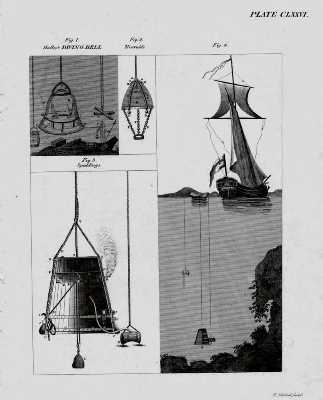Diving Bell
The diving bell is used to increase the supply of air
available to persons working underwater. The device was invented in the
16th century, and had been used in several explorations of wrecks to recover
sunken treasure by the end of the 17th century.
"The impenetrability of air is shown by the Diving-Bell,
... shaped somewhat line an inverted tumbler... As the vessel descends,
the air in it is condensed by the upward pressure of the liquid, and water
enters. The lower it gets, the more the air is compressed, and the greater
the amount of water admitted. The impenetrability of the air, however,
keeps the greater part of the bell clear of water, so that several persons
may descend in it to the bottom of the sea." From G. P. Quackenbos, A
Natural Philosophy (D. Appleton and Company, New York, 1866), pp 166-167
|
|
| The copperplate engraving is from the fifth edition of the Brittanica
published in Edinburgh, Scotland in 1815. The three diving bells are those
developed by Halley, Spalding and Triewald. |
 |
|